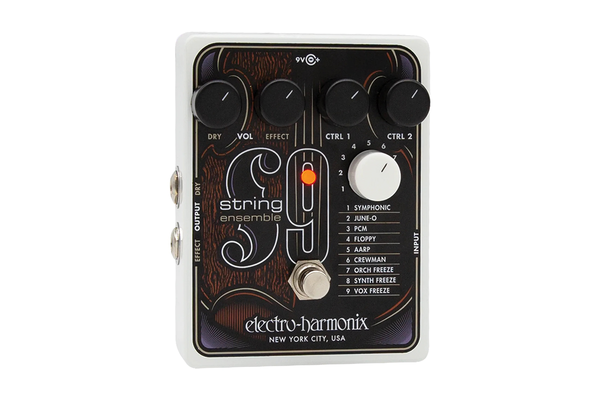Electro-Harmonix is a giant among pedal builders. What’s inspiring about EHX is that they’ve never let that stature keep them from taking risks. Take the company’s keyboard- and synth-inspired pedals: the B9, KEY9, MEL9, and Synth9. Each has been a success, but none were sure-fire hits. Guitar-based synthesis at accessible consumer prices is not easy. Yet in each case, EHX created something playable and useful to guitarists. And if they didn’t always achieve perfect replication of the keyboard and synth instruments that inspired them, the pedals often prompted new ways of relating to a guitar and new possibilities in performance and composition. The S9 String Ensemble is among the most realized of these pedals. Its sounds are rich and creatively executed. And the pedal is compelling in the truest sense of the word: It makes it virtually impossible to not consider new songs, new arrangements, and new styles as you interact with it.
Electro-Harmonix is a giant among pedal builders. What’s inspiring about EHX is that they’ve never let that stature keep them from taking risks. Take the company’s keyboard- and synth-inspired pedals: the B9, KEY9, MEL9, and Synth9. Each has been a success, but none were sure-fire hits. Guitar-based synthesis at accessible consumer prices is not easy. Yet in each case, EHX created something playable and useful to guitarists. And if they didn’t always achieve perfect replication of the keyboard and synth instruments that inspired them, the pedals often prompted new ways of relating to a guitar and new possibilities in performance and composition. The S9 String Ensemble is among the most realized of these pedals. Its sounds are rich and creatively executed. And the pedal is compelling in the truest sense of the word: It makes it virtually impossible to not consider new songs, new arrangements, and new styles as you interact with it.
Most striking is the pedal’s capacity for translating complex chords in patches that feature more virtual instruments and/or complex overtone clusters.
Don't Tell the String Players Union
The S9’s sounds span a range of relatively organic and synthesized string sounds including voices inspired by the Arp Solina, Crumar Performer, Roland Juno series, Mellotron, and Vako Orchestron. The pedal also utilizes EHX’s Freeze effect in combination with three of the voices in order to create string-based pads. Impressively, managing these many sounds is simple and intuitive.
The dry and effect knobs act as a little mixer for both signals. There are also effect and dry outputs. You use the former if you’re running a single amp or DAW. The dry output sends a buffered signal that bypasses the effect entirely and enables all kinds of wet/dry mix possibilities when used with a second amp or second input channel in a DAW. The potential to create huge, complex, and cohesive sounds with these two output options alone is very cool. The ctrl 1 and ctrl 2 knobs change function depending on the voice that you select with the white patch knob. Some players might lament the limited control of synth parameters, but the economy of design here is equally appealing in my book.
Pocket Symphonies
The biggest challenge in working with a pedal like the S9 is adjusting the way you play relative to synthesis. The good news is that latency is rarely a problem on the S9, unless you’re trying to play rapid-fire Chet Atkins licks. Most striking is the pedal’s capacity for translating complex chords in patches like symphonic and floppy that feature more virtual instruments and/or complex overtone clusters. In fact, full-spectrum chords with big bass notes and treble detail seem to summon the best and most beautiful sounds from the S9. Anyone familiar with the glitchiness and latency in old MIDI rigs is likely to be bowled over by how absent those issues are in an affordable and simple stompbox.
Each voice on the S9 is full of possibilities. The symphonic voice is not a perfect emulation of a real orchestra—you still hear traces of digital synthesis that are less than flattering to the high-mid frequency oriented “instruments.” But darkening the tone and bumping up the sustain via the ctrl 1 and ctrl 2 creates a cool, hazy version of a string section sound. The symphonic voice—and others— also benefit from volume-swell techniques, which soften pick attack and stray extra-loud transients that often pop up in the high mids.
The approximations of string synths are my favorite S9 sounds. Curiously, these modes often do a better job of conveying orchestral moods than the symphonic voice. That perception is totally subjective; my view is shaped by an enthusiasm for archaic string synths and enjoying the suspension of disbelief intrinsic to using them. Whatever your view, these voices are fun. The June-O voice sounds awesome in the context of ominous bassy triads. And it’s easy to imagine slow-phasing AARP sounds flipping a song on its head as part of a bridge or chorus. My favorite voice though is the floppy patch, which approximates the gauzy sounds of a vintage Orchestron, which used optical discs like a Mellotron used tape. The blurrier interpretations of symphony sounds, with their softer transients and more glued-together picture of multiple instruments, are well suited to guitar phrasing.
The Verdict
The S9 won’t replicate the sound of a symphony string section the way a Hollywood soundtrack artist’s workstation will. Nor does it nail the sounds of an Arp Solina. But you can chalk up most of the subjective shortcomings to the inherent limitations of a guitar-synth interface. In light of that constraint, the S9 and its core sounds are impressive. As with any synth pedal, you have to be open-minded about technique and what constitutes accuracy. But for players with less defined musical boundaries, the S9 can be a prompt for wild, new musical directions.


















